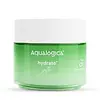What's inside
What's inside
 Key Ingredients
Key Ingredients

 Benefits
Benefits

 Concerns
Concerns

 Ingredients Side-by-side
Ingredients Side-by-side

Water
Skin ConditioningDimethicone
EmollientGlycerin
HumectantButylene Glycol
HumectantAmmonium Acryloyldimethyltaurate/Vp Copolymer
Ethylhexylglycerin
Skin ConditioningPhenoxyethanol
PreservativeLinoleamidopropyl Pg-Dimonium Chloride Phosphate
Ammonium Acryloyldimethyltaurate Crosspolymer
Emulsion StabilisingDimethicone Crosspolymer
Emulsion StabilisingCaprylic/Capric Triglyceride
MaskingHyaluronic Acid
HumectantNiacinamide
SmoothingSodium PCA
HumectantStearic Acid
CleansingXylitylglucoside
HumectantAnhydroxylitol
HumectantXylitol
HumectantAcrylates/Beheneth-25 Methacrylate/Hema Crosspolymer
Emulsion StabilisingPersea Gratissima Oil
Skin ConditioningLaminaria Digitata Extract
Skin ProtectingCetyl-Pg Hydroxyethyl Palmitamide
Skin ConditioningCeramide 1
Skin ConditioningCeramide 2
Skin ConditioningCeramide 3
Skin ConditioningCeramide 4
Skin ConditioningCeramide 6 Ii
Skin ConditioningCI 19140
Cosmetic ColorantCI 42090
Cosmetic ColorantWater, Dimethicone, Glycerin, Butylene Glycol, Ammonium Acryloyldimethyltaurate/Vp Copolymer, Ethylhexylglycerin, Phenoxyethanol, Linoleamidopropyl Pg-Dimonium Chloride Phosphate, Ammonium Acryloyldimethyltaurate Crosspolymer, Dimethicone Crosspolymer, Caprylic/Capric Triglyceride, Hyaluronic Acid, Niacinamide, Sodium PCA, Stearic Acid, Xylitylglucoside, Anhydroxylitol, Xylitol, Acrylates/Beheneth-25 Methacrylate/Hema Crosspolymer, Persea Gratissima Oil, Laminaria Digitata Extract, Cetyl-Pg Hydroxyethyl Palmitamide, Ceramide 1, Ceramide 2, Ceramide 3, Ceramide 4, Ceramide 6 Ii, CI 19140, CI 42090
Water
Skin ConditioningButylene Glycol
HumectantHydroxyethyl Urea
HumectantHydrogenated Polyisobutene
EmollientSilica
AbrasiveAmmonium Polyacryloyldimethyl Taurate
Emulsion StabilisingN-Vinyl Pyrrolidone
Glycerin
HumectantSaccharide Isomerate
HumectantCitric Acid
BufferingSodium Citrate
BufferingCocos Nucifera Water
MaskingCetearyl Olivate
Sorbitan Olivate
EmulsifyingGlyceryl Glucoside
HumectantAloe Barbadensis Leaf Juice
Skin ConditioningPhenoxyethanol
PreservativeAvena Strigosa Seed Extract
Skin ConditioningLecithin
EmollientPotassium Sorbate
PreservativeAphanothece Sacrum Polysaccharide
AbsorbentSodium Hyaluronate
HumectantDisodium EDTA
Sodium Acrylates Copolymer
Parfum
MaskingCI 42053
Cosmetic ColorantCI 19140
Cosmetic ColorantCI 42090
Cosmetic ColorantWater, Butylene Glycol, Hydroxyethyl Urea, Hydrogenated Polyisobutene, Silica, Ammonium Polyacryloyldimethyl Taurate, N-Vinyl Pyrrolidone, Glycerin, Saccharide Isomerate, Citric Acid, Sodium Citrate, Cocos Nucifera Water, Cetearyl Olivate, Sorbitan Olivate, Glyceryl Glucoside, Aloe Barbadensis Leaf Juice, Phenoxyethanol, Avena Strigosa Seed Extract, Lecithin, Potassium Sorbate, Aphanothece Sacrum Polysaccharide, Sodium Hyaluronate, Disodium EDTA, Sodium Acrylates Copolymer, Parfum, CI 42053, CI 19140, CI 42090
Ingredients Explained
These ingredients are found in both products.
Ingredients higher up in an ingredient list are typically present in a larger amount.
Butylene Glycol (or BG) is used within cosmetic products for a few different reasons:
Overall, Butylene Glycol is a safe and well-rounded ingredient that works well with other ingredients.
Though this ingredient works well with most skin types, some people with sensitive skin may experience a reaction such as allergic rashes, closed comedones, or itchiness.
Learn more about Butylene GlycolCI 19140 is also known as Tartrazine. Tartrazine is a synthetic dye used in cosmetics, foods, and medicine to add a yellow color.
Tartrazine is created from petroleum and is water-soluble.
Some people may experience allergies from this dye, especially asthmatics and those with an aspirin intolerance.
Learn more about CI 19140Ci 42090 is a synthetic dye created from petroleum. It is used to give a bright blue color to cosmetics, medicine, and food.
Glycerin is already naturally found in your skin. It helps moisturize and protect your skin.
A study from 2016 found glycerin to be more effective as a humectant than AHAs and hyaluronic acid.
As a humectant, it helps the skin stay hydrated by pulling moisture to your skin. The low molecular weight of glycerin allows it to pull moisture into the deeper layers of your skin.
Hydrated skin improves your skin barrier; Your skin barrier helps protect against irritants and bacteria.
Glycerin has also been found to have antimicrobial and antiviral properties. Due to these properties, glycerin is often used in wound and burn treatments.
In cosmetics, glycerin is usually derived from plants such as soybean or palm. However, it can also be sourced from animals, such as tallow or animal fat.
This ingredient is organic, colorless, odorless, and non-toxic.
Glycerin is the name for this ingredient in American English. British English uses Glycerol/Glycerine.
Learn more about GlycerinPhenoxyethanol is a preservative that has germicide, antimicrobial, and aromatic properties. Studies show that phenoxyethanol can prevent microbial growth. By itself, it has a scent that is similar to that of a rose.
It's often used in formulations along with Caprylyl Glycol to preserve the shelf life of products.
Water. It's the most common cosmetic ingredient of all. You'll usually see it at the top of ingredient lists, meaning that it makes up the largest part of the product.
So why is it so popular? Water most often acts as a solvent - this means that it helps dissolve other ingredients into the formulation.
You'll also recognize water as that liquid we all need to stay alive. If you see this, drink a glass of water. Stay hydrated!
Learn more about Water